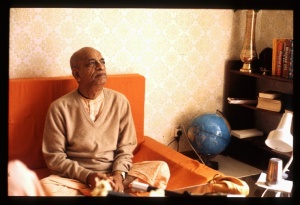SB 4.29.69

A.C. Bhaktivedanta Swami Prabhupada
TEXT 69
- sattvaika-niṣṭhe manasi
- bhagavat-pārśva-vartini
- tamaś candramasīvedam
- uparajyāvabhāsate
SYNONYMS
sattva-eka-niṣṭhe — in full Kṛṣṇa consciousness; manasi — in a mind; bhagavat — with the Supreme Personality of Godhead; pārśva-vartini — being constantly associated; tamaḥ — the dark planet; candramasi — in the moon; iva — like; idam — this cosmic manifestation; uparajya — being connected; avabhāsate — becomes manifest.
TRANSLATION
Kṛṣṇa consciousness means constantly associating with the Supreme Personality of Godhead in such a mental state that the devotee can observe the cosmic manifestation exactly as the Supreme Personality of Godhead does. Such observation is not always possible, but it becomes manifest exactly like the dark planet known as Rāhu, which is observed in the presence of the full moon.
PURPORT
It has been explained in the previous verse that all desires on the mental platform become visible one after another. Sometimes, however, by the supreme will of the Supreme Personality of Godhead, the whole stockpile can be visible all at one time. In Brahma-saṁhitā (BS 5.38) it is said, karmāṇi nirdahati kintu ca bhakti-bhājām. When a person is fully absorbed in Kṛṣṇa consciousness, his stockpile of material desires is minimized. Indeed, the desires no longer fructify in the form of gross bodies. Instead, the stockpile of desires becomes visible on the mental platform by the grace of the Supreme Personality of Godhead.
In this connection, the darkness occurring before the full moon, the lunar eclipse, can be explained as being another planet, known as Rāhu. According to Vedic astronomy, the Rāhu planet, which is not visible, is accepted. Sometimes the Rāhu planet is visible in the presence of full moonlight. It then appears that this Rāhu planet exists somewhere near the orbit of the moon. The failure of modern moon excursionists may be due to the Rāhu planet. In other words, those who are supposed to be going to the moon may actually be going to this invisible planet Rāhu. Actually, they are not going to the moon but to the planet Rāhu, and after reaching this planet, they come back. Apart from this discussion, the point is that a living entity has immense and unlimited desires for material enjoyment, and he has to transmigrate from one gross body to another until these desires are exhausted.
No living entity is free from the cycle of birth and death unless he takes to Kṛṣṇa consciousness; therefore in this verse it is clearly stated (sattvaika-niṣṭhe) that when one is fully absorbed in Kṛṣṇa consciousness, in one stroke he is freed of past and future mental desires. Then, by the grace of the Supreme Lord, everything becomes simultaneously manifest within the mind. In this regard, Viśvanātha Cakravartī Ṭhākura cites the example of mother Yaśodā's seeing the whole cosmic manifestation within the mouth of Lord Kṛṣṇa. By the grace of Lord Kṛṣṇa, mother Yaśodā saw all the universes and planets within the mouth of Kṛṣṇa. Similarly, by the grace of the Supreme Personality of Godhead, Kṛṣṇa, a Kṛṣṇa conscious person can see all his dormant desires at one time and finish all his future transmigrations. This facility is especially given to the devotee to make his path clear for returning home, back to Godhead.
Why we see things not experienced in this life is explained herein. That which we see is the future expression of a gross body or is already stocked in our mental stockpile. Because a Kṛṣṇa conscious person does not have to accept a future gross body, his recorded desires are fulfilled in a dream. We therefore sometimes find things in a dream never experienced in our present life.